The Golden Age of Comic Covers: Why They Still Captivate Us
Discover the timeless appeal of Golden Age comic covers, their vibrant artistry, profound cultural significance, and enduring legacy. Learn why these iconic visual narratives make the perfect statement pieces for your wall art collection and explore how Punch Comics Shop brings this captivating history to life through stunning metal prints.
Punch Prints
6/29/202514 min read
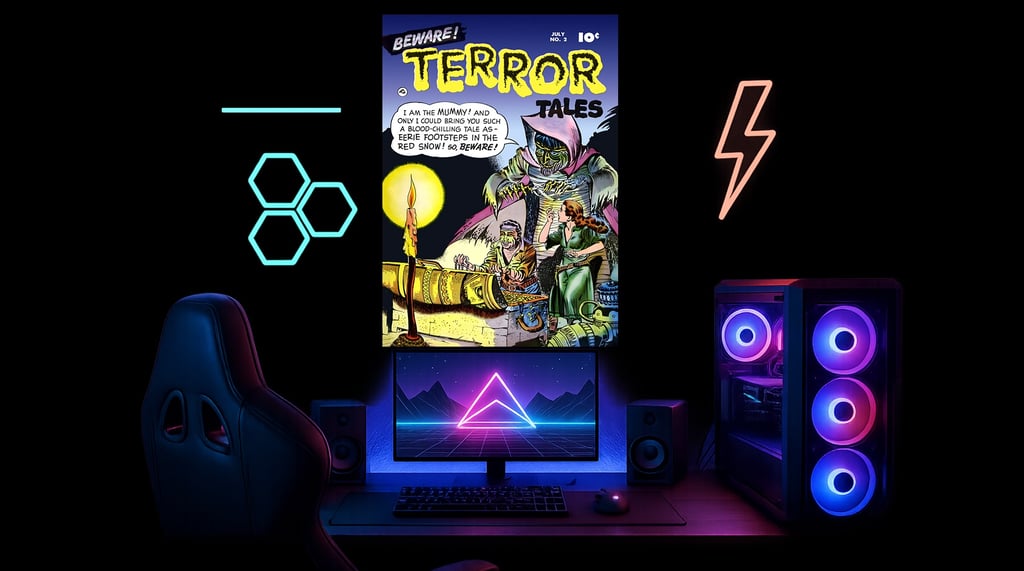

I. Introduction: A Window to a Bygone Era, Perfect for Your Walls
Imagine yourself transported back to a bustling 1940s newsstand. Rows upon rows of magazines vie for attention, but one vibrant display truly leaps out. Amidst the sea of daily papers and glossy weeklies, a new kind of publication explodes with color and raw energy: the comic book. Perhaps it's a terrifying ape snatching a screaming victim from a rickety ladder, the bold title "Chamber of Chills" screaming above them in stark, blood-red lettering. Or maybe it’s a patriotic hero, shield raised, punching a real-world dictator square in the jaw. These aren't just flimsy pamphlets; they are powerful visual narratives, designed to grab your attention instantly.
What is it about these vintage comic covers that still grabs our attention, decades later, and makes them perfect for display as stunning wall art?
Welcome to the Golden Age of Comic Books, an electrifying period stretching roughly from the 1938 debut of Superman in Action Comics #1 to the mid-1950s, around 1956. This wasn't just a fleeting trend; it was the birth of an industry, a cultural phenomenon where modern comic books were first published, rapidly gained immense popularity, and birthed the entire superhero archetype that dominates our screens and imaginations even today. It was a time of boundless creativity and raw visual storytelling, cementing the comic book as a major force in publishing and popular culture.
But the appeal of these Golden Age covers goes far beyond their historical significance. They are bold, innovative visual narratives that perfectly encapsulated their tumultuous times—a world grappling with the Great Depression, the harrowing realities of World War II, and the uneasy dawn of the Cold War. They continue to inspire, holding a timeless appeal for art enthusiasts, history buffs, and crucially, anyone looking for unique, impactful wall art that tells a story and injects vibrant personality into their space.
Join us as we journey back to this captivating era, dissecting the artistry, cultural weight, and enduring legacy of Golden Age comic covers. By the end, you’ll not only understand why these masterpieces still captivate us, but why they are the ideal candidates to become the next bold statement piece proudly displayed on your wall.
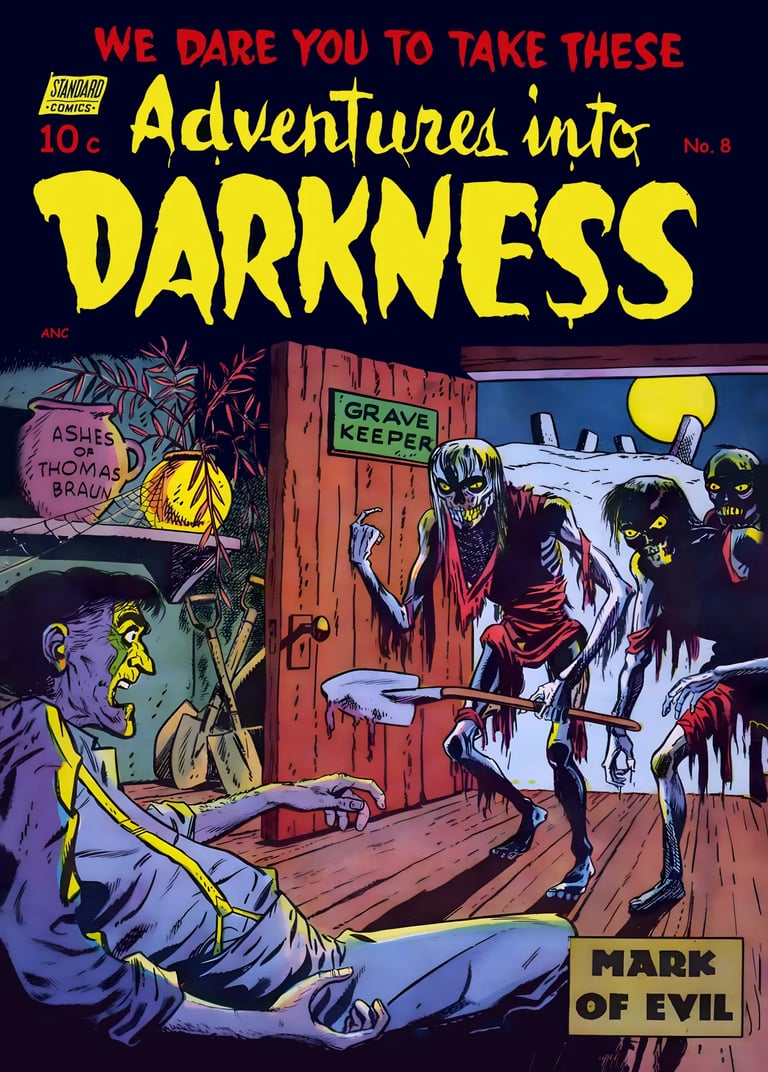

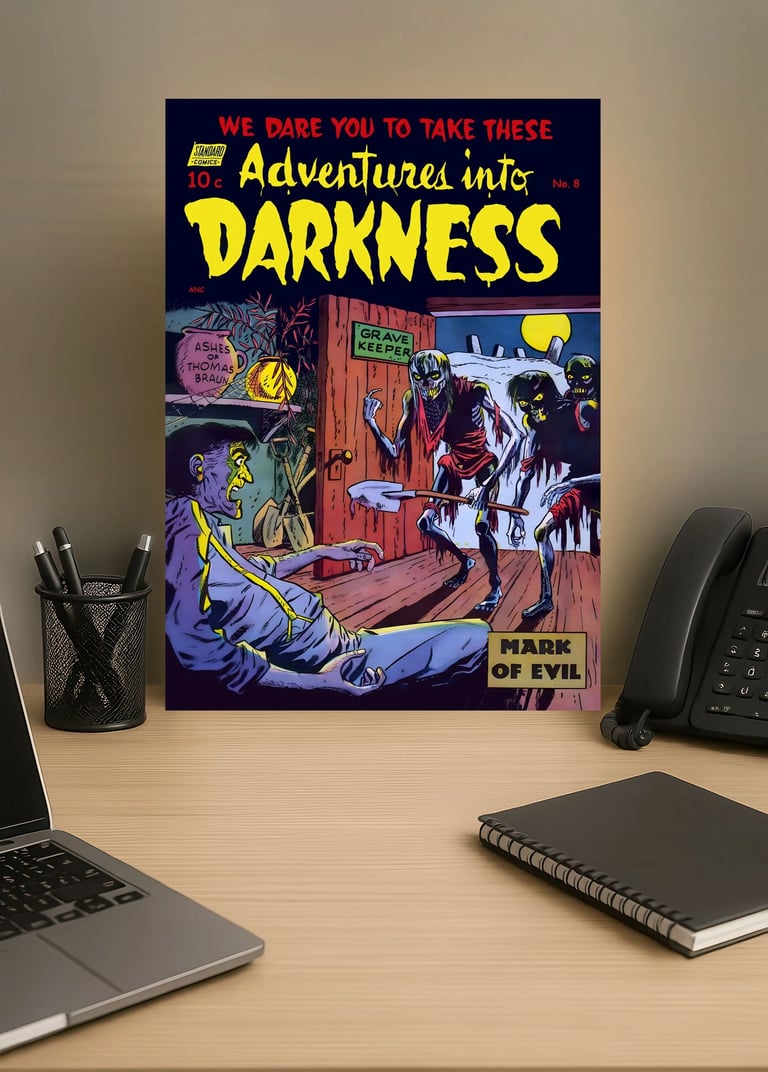

II. The Artistry and Undeniable Appeal of Golden Age Covers: Designed to Be Seen
The aesthetic of Golden Age comic covers wasn't born out of purely artistic whim; it was a brilliant fusion of necessity, innovation, and an innate understanding of how to capture the eye. These covers were, at their heart, advertisements, desperate to stand out in a crowded newsstand landscape, and their design principles make them exceptionally well-suited for striking wall art.
Boldness and Simplicity: A Masterclass in Visual Impact
Early comic book production was a far cry from today’s digital precision. Comics were printed on cheap newsprint, and the technology for color reproduction was limited. This forced artists to work with constraints that, paradoxically, birthed a uniquely powerful and direct visual style.
Necessity as the Mother of Style: Artists relied heavily on bold outlines, strong linework, and a palette dominated by primary colors – vibrant reds, sunny yellows, and deep blues. These aren't subtle pastels; these are colors that scream for attention. This inherent visual power translates exceptionally well when displayed as wall art, as the colors retain their intensity and clarity even from a distance, refusing to blend passively into the background. Think of the iconic red and blue of Superman, or Captain America's stars and stripes – these visuals were designed to be seen and make an impact, making them ideal for larger-format display on your walls. Their simplicity is their strength, cutting through visual clutter.
The Ben-Day Dot Technique: A fascinating element of this era's printing was the widespread use of Ben-Day dots. These small, evenly spaced dots of color were layered to create shades and tones. When viewed up close, you can often discern the individual dots, a charming artifact of the printing process. When these covers are reproduced on a larger scale, like a metal print, these dots often become a subtle texture, adding a layer of authenticity and visual interest that's absent in modern, digitally rendered art. This unique texture adds to their appeal as genuine pieces of historical art for your home.
Commanding Compositions: Golden Age artwork was never shy. It was designed for immediate impact, with clear, dynamic compositions that conveyed action and drama at a glance. Heroes leapt, villains snarled, and damsels were perpetually in distress, all within a single, powerful image. Imagine these powerful scenes commanding attention as a centerpiece on your lounge or game room wall. They don't just decorate; they narrate, drawing the viewer into an instant story. The limited space of a cover forced artists to distill narratives into a single, compelling tableau, a skill that directly translates to their power as independent pieces of art.
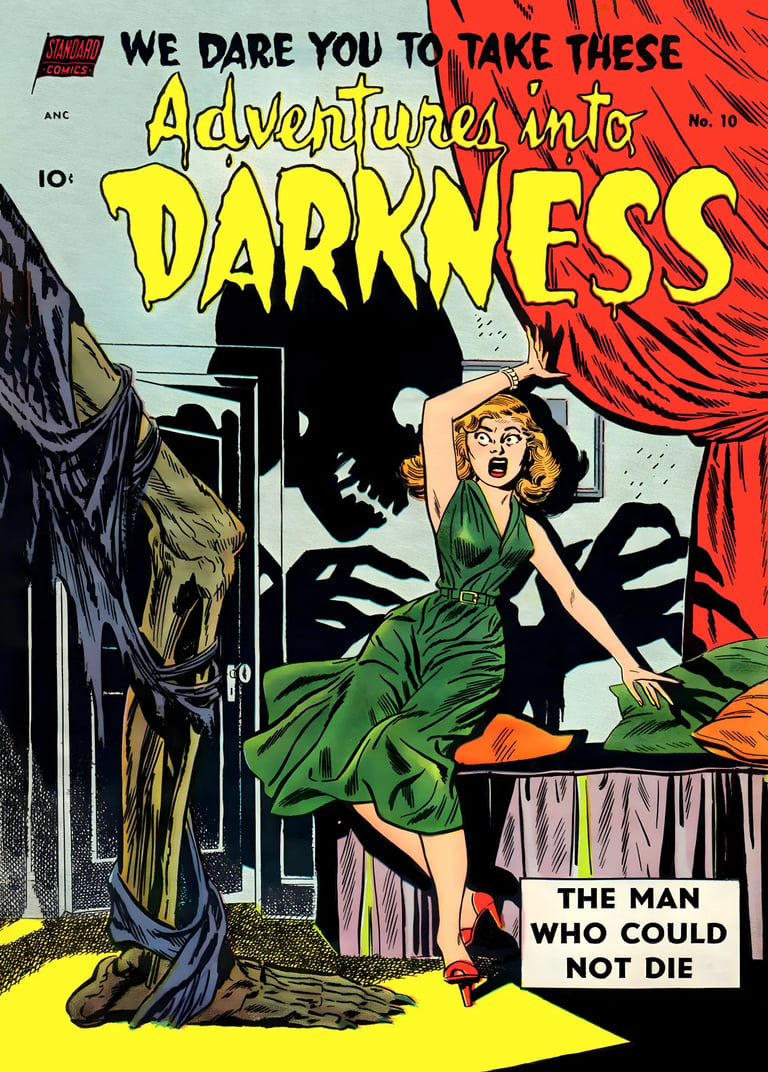



Pulp Sensibility: Drama and Energy Unleashed
Before comic books, pulp magazines dominated the popular fiction landscape, known for their sensational stories and equally sensational covers. Golden Age comic artists often drew heavily from this "pulp" sensibility, infusing their covers with an undeniable raw energy and dramatic flair.
Exaggerated Emotion and Action: Covers often featured exaggerated poses, dramatic lighting, and a raw, energetic style reminiscent of those thrilling pulp magazines and the dynamic, often melodramatic, visuals of early cinema. Think of the intense shadows, the over-the-top expressions, and the sense of impending doom or triumphant victory. This inherent drama makes them captivating and conversation-starting pieces of wall art, inviting viewers to speculate on the story unfolding within the single frame.
Genre Goldmine: While superheroes would become synonymous with the Golden Age, the era actually boasted incredible diversity. Golden Age covers also showcased vibrant artwork for horror, crime, Western, romance, and sci-fi comics. Each genre had its unique visual tropes – the lurid, macabre scenes of "pre-Code horror" (like your Chamber of Chills example), the gritty realism of crime noir, or the fantastical futurism of early sci-fi. No matter your passion, there's a Golden Age cover waiting to become your next favorite wall art, reflecting a rich tapestry of American popular imagination.
Iconic Imagery: Displaying the Birth of Legends
The Golden Age wasn't just about bold aesthetics; it was about the birth of characters who would become global icons, their very first appearances often immortalized on these early covers.
Character Debuts: This era introduced a pantheon of now-legendary characters that continue to shape our entertainment landscape: Superman, Batman, Wonder Woman, The Flash, Green Lantern, Captain America, and notably, Captain Marvel. It's a fascinating historical footnote that Captain Marvel, published by Fawcett Comics, was, for a time, so popular that he outsold even Superman, necessitating biweekly printings to meet demand. Owning a metal print of these historic first appearances allows you to display a true piece of pop culture history – the very moment these characters burst onto the scene. It's like having a museum piece dedicated to the origin of modern mythology.
Memorable and Controversial Moments: Many covers depicted powerful, often controversial, images that instantly became iconic. The famous cover of Captain America Comics #1 (March 1941) showing the hero punching Adolf Hitler in the face, months before the U.S. officially entered WWII, was a groundbreaking statement of patriotism and anti-fascist sentiment. Your Chamber of Chills cover with the monstrous gorilla seizing a victim perfectly exemplifies the pulpy, dramatic horror art of the era – perfect for bold, statement wall decor that speaks to a specific genre appreciation. These covers captured the zeitgeist, reflecting and shaping public sentiment in powerful ways.
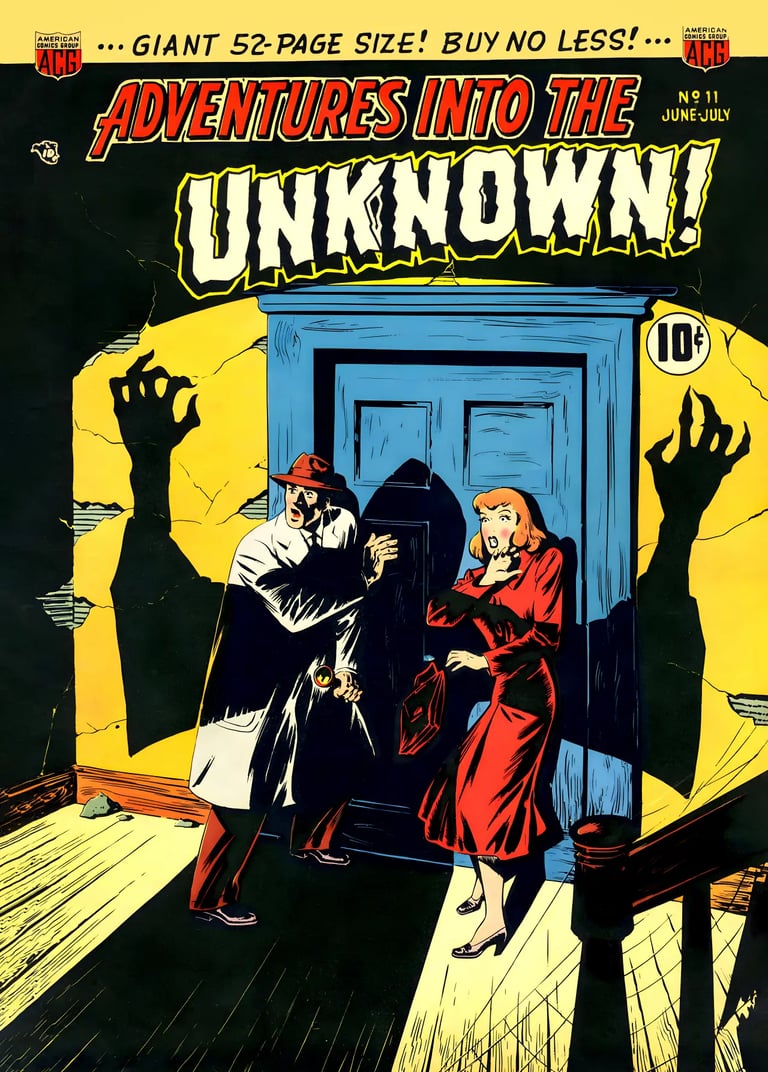

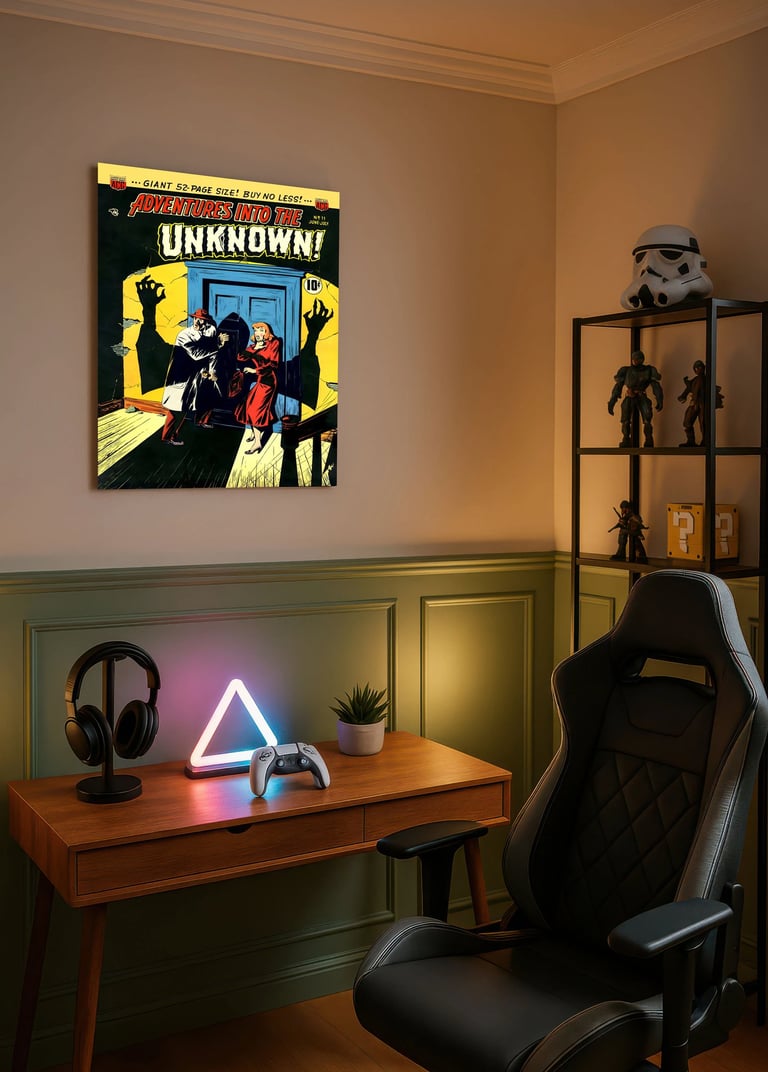

III. More Than Just Art: Cultural Significance as Visual Time Capsules
Golden Age comic covers weren't just commercial art; they were cultural artifacts, reflecting the hopes, fears, and values of a nation in constant flux. Displaying these covers as wall art is akin to owning a visual timestamp of history, a direct connection to defining moments of the 20th century.
Historical Context: Reflecting a Tumultuous World
The period of the Golden Age was one of immense global upheaval, and comic books, surprisingly, became a vital mirror of these times.
The Great Depression and Escapism: As the 1930s drew to a close, America was still grappling with the economic devastation of the Great Depression. Superheroes, with their seemingly limitless power and ability to right wrongs, offered a potent form of escapism. They were symbols of hope and justice in a world that often felt devoid of both. Having these symbols on your wall can serve as a reminder of resilience and the enduring human desire for heroism.
World War II and Propaganda: The onset of World War II fundamentally shifted the narrative of comic books. After the attack on Pearl Harbor in December 1941, comics became an unofficial, yet incredibly effective, tool for national morale and propaganda.
Battling the Axis: Heroes like Captain America, Superman, and Wonder Woman were depicted fighting Nazi spies, thwarting enemy plans, and directly engaging with Axis forces on their covers. These powerful historical narratives make for compelling and meaningful wall decor, sparking conversations about history, heroism, and the role of popular culture in wartime.
Homefront Support: Covers often encouraged readers to support the troops, buy war bonds and stamps, and participate in scrap metal drives. This taught children about civic duty and reinforced a positive view of the American war effort. A metal print of such a cover serves not only as art but as a piece of social history, illustrating a unique intersection of entertainment and national duty.
Racial Stereotypes: It's also important to acknowledge that some WWII-era covers, while historically significant, contained problematic racial stereotypes, particularly concerning Japanese characters, reflecting the prejudices of the time. These elements, though discomforting today, are part of the historical record and offer a lens through which to discuss the complex nuances of the past.
The Atomic Age and Cold War Fears: As WWII ended, the Cold War dawned, and with it, new anxieties about nuclear power and global conflict. Comic books adapted, shifting from overt wartime themes to more subtle reflections of these new fears, often moving into sci-fi and mystery genres. The artwork of this transitional period captures a unique post-war aesthetic, ripe for thought-provoking wall art.
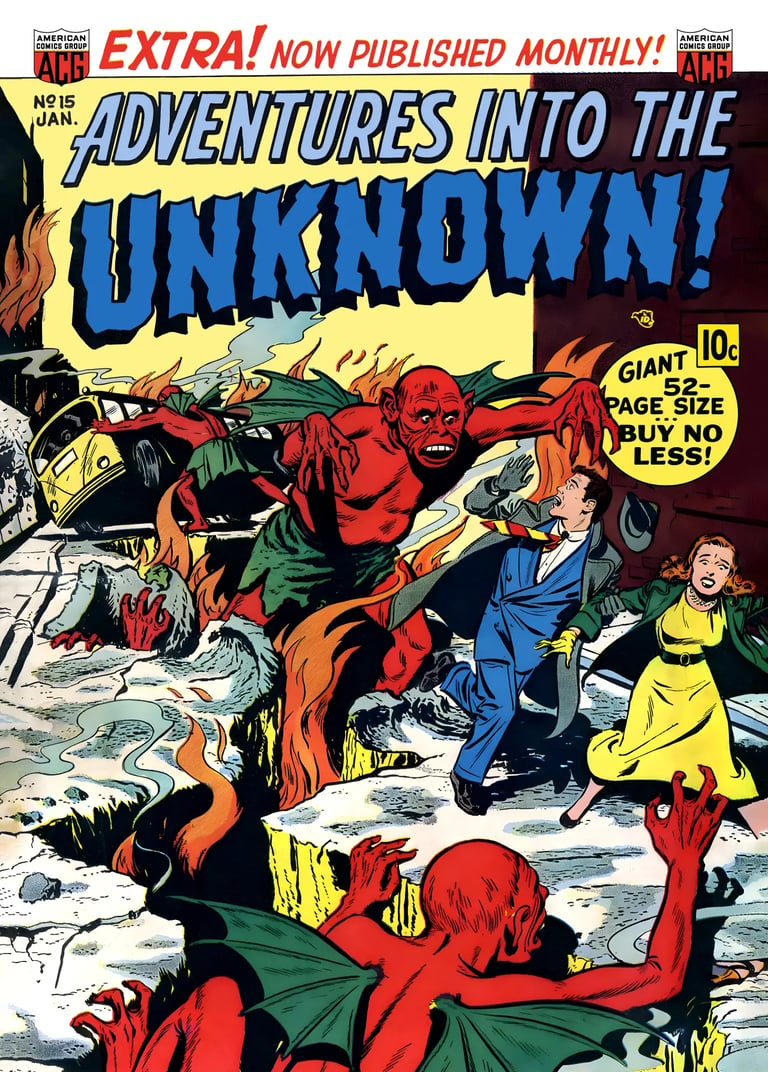

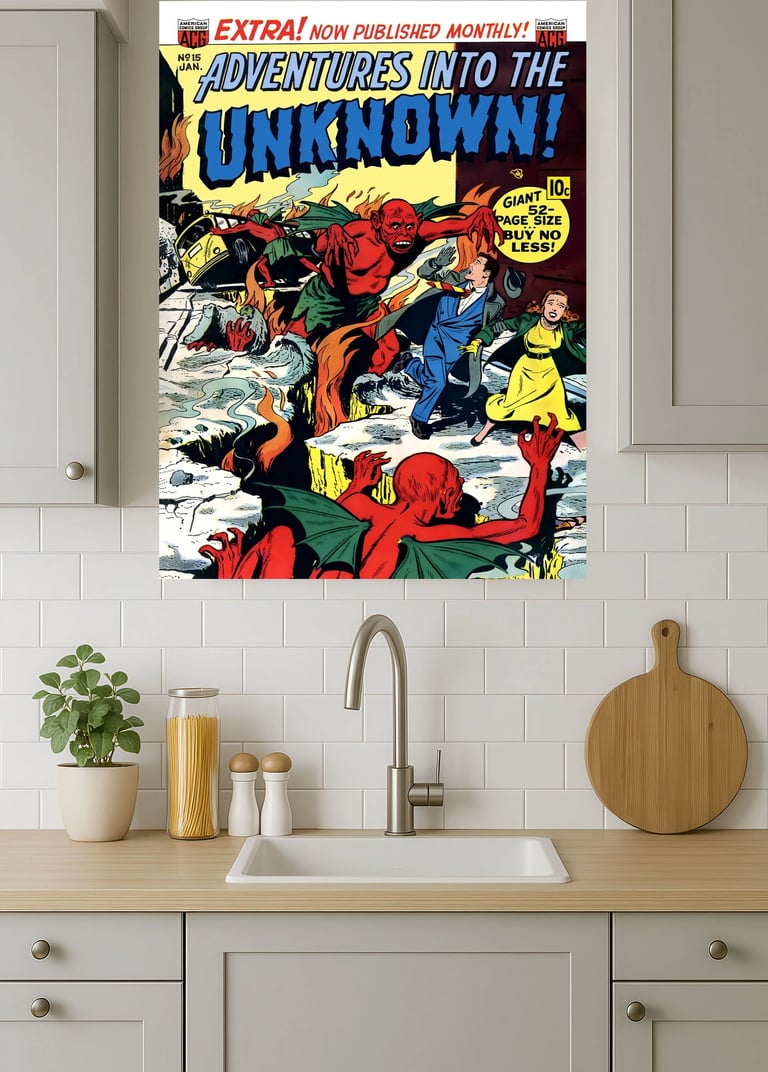

Innovation in Storytelling: The Art of the Single Image
The era was crucial in developing the defined visual language and creative conventions of comic books. What's often overlooked is the sheer ingenuity required to convey a complex narrative within the confines of a single cover image.
Visual Vocabulary: Early comic artists were pioneers, establishing a visual vocabulary that is still understood today: speed lines for motion, impact bursts for sound, and distinct character designs that communicated personality at a glance. This foundational visual vocabulary makes these covers intrinsically artistic and visually engaging for any wall, serving as a masterclass in concise visual communication.
Pioneering Artists and Their Grand Vision: Artists like Joe Shuster (co-creator of Superman, whose clean, almost minimalist style defined the superhero look), Bob Kane (Batman, who brought a touch of noir and shadows to Gotham), and the dynamic early work of Jack Kirby (Captain America, whose explosive compositions hinted at his later legendary style) weren't just drawing; they were defining the look and feel of a new medium. Their groundbreaking work is meant to be appreciated on a grand scale, like a premium metal print, allowing you to study the details and appreciate the artistic decisions that shaped an entire industry.
First Impressions: The Battle for the Newsstand
In a time when comic books were a novel and inexpensive form of entertainment – typically costing just 10 cents – the cover was everything.
Crucial Marketing Tool: Without the benefit of extensive advertising campaigns or widespread brand recognition, the cover was the primary marketing tool. It had to instantly grab a reader's attention from a pile of dozens of other titles and tell enough of a story to convince them to part with their dime. This inherent "stopping power" is precisely what makes them perfect for attention-grabbing wall art in any space. They were designed to compel, to spark curiosity, and to promise adventure, and they still do.
The Power of Promise: A good Golden Age cover didn't just show a scene; it promised an entire adventure. It hinted at the thrills and dangers within, creating a powerful psychological draw. When displayed as art, they continue to evoke that same sense of wonder and excitement, serving as mini-portals to an age of unrestrained imagination.
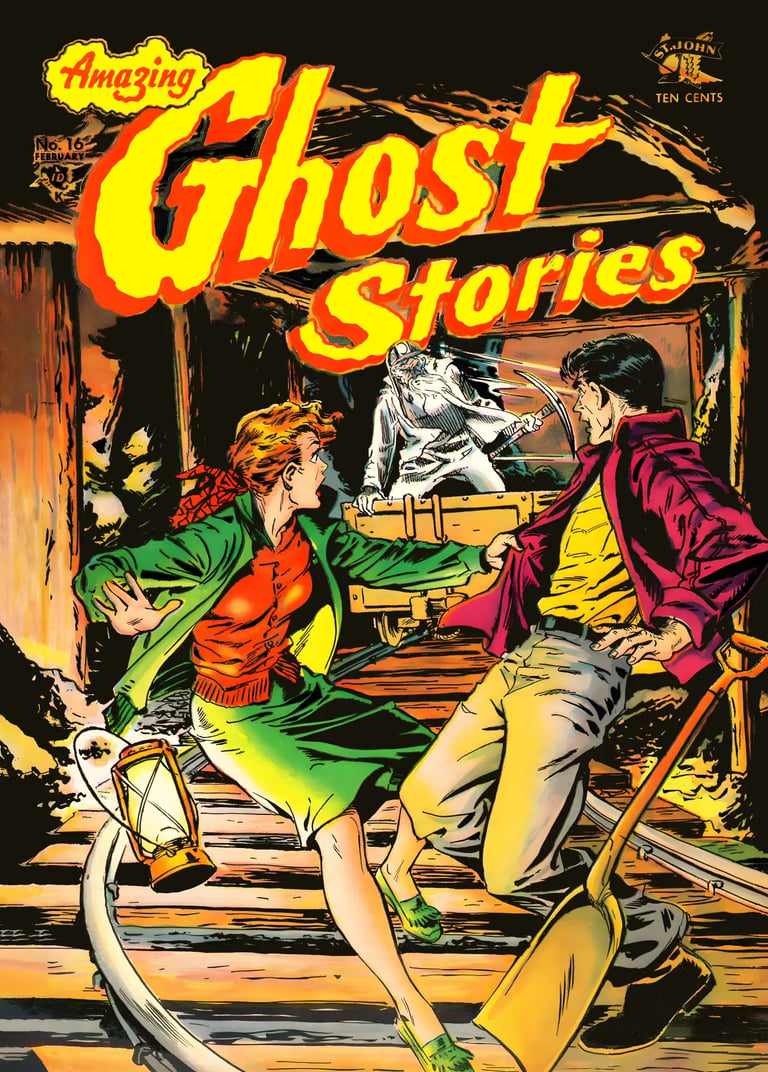

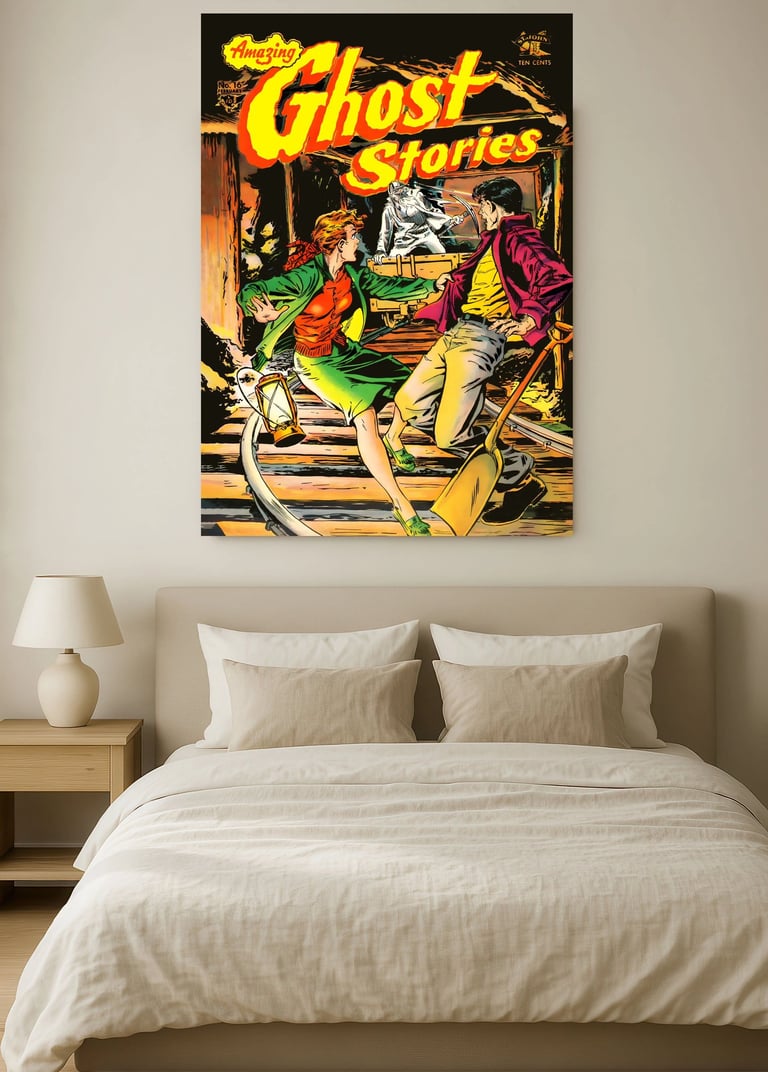

IV. The Enduring Legacy and Collectibility: From Rarity to Ready-to-Hang Art
The appeal of Golden Age comic covers has only grown with time, transforming from ephemeral entertainment into highly coveted collector's items and, more recently, into stunning pieces of contemporary art for the home.
The Potent Pull of Nostalgia
These covers evoke a powerful sense of nostalgia, transporting viewers back to a simpler, bolder era of storytelling and heroism. For those who grew up with them, they are cherished memories. For younger generations, they offer a fascinating glimpse into the origins of beloved characters and a different stylistic sensibility. They represent a tangible link to a significant period in pop culture history, making them cherished pieces of art for your home, resonating deeply with personal or collective memories. This emotional connection makes them more than just decor; they are storytellers.
Influence on Modern Art & Pop Culture: The DNA of Contemporary Visuals
The impact of Golden Age comic covers extends far beyond the comic book world itself. They are the foundational DNA of much of modern visual culture.
Foundation of Universes: The Golden Age laid the essential groundwork for today's multi-billion dollar comic book and cinematic universes. Without these early heroes and their visual identities, the Marvel Cinematic Universe or DC's vast filmography simply wouldn't exist as we know them. Displaying these iconic covers connects your space to this vast, influential pop culture landscape, acknowledging its roots and celebrating its evolution. It's a nod to the origins of the characters and stories that captivate millions worldwide.
The Pop Art Movement: Comics Go High Art: Perhaps one of the most direct and profound influences of Golden Age comic aesthetics can be seen in the Pop Art movement of the 1950s and 60s. Artists like Roy Lichtenstein famously took individual panels and entire comic covers, exaggerated their bold lines, primary colors, and the distinctive Ben-Day dots, and transformed them into monumental paintings. Lichtenstein’s Whaam! and Drowning Girl are prime examples of how he elevated what was considered "low art" (comics) into "high art" displayed in galleries and museums, blurring the lines between the two. He didn't just reproduce; he reinterpreted, challenging traditional notions of art. Andy Warhol, another titan of Pop Art, similarly drew inspiration from everyday consumer culture, and comics fit perfectly into this celebration of mass-produced imagery. Bringing this "Pop Art" history to your walls through original Golden Age designs is a powerful artistic statement, celebrating the influence of comics on the broader art world. It acknowledges the groundbreaking shift in perception that these images brought about.
Contemporary Art and Design: Even today, the visual codes of Golden Age comics are ubiquitous. Street artists like Banksy and Shepard Fairey often incorporate bold outlines, limited color palettes, and impactful imagery that harks back to early comic art. Digital artists frequently recreate Ben-Day dot effects or emulate the dynamic compositions. Graphic designers and advertisers continue to draw on the Golden Age's ability to communicate quickly and effectively. Your metal prints allow you to display the original inspiration for so much modern art and design, showcasing the enduring power of these pioneering visuals. They are timeless design principles that remain relevant.
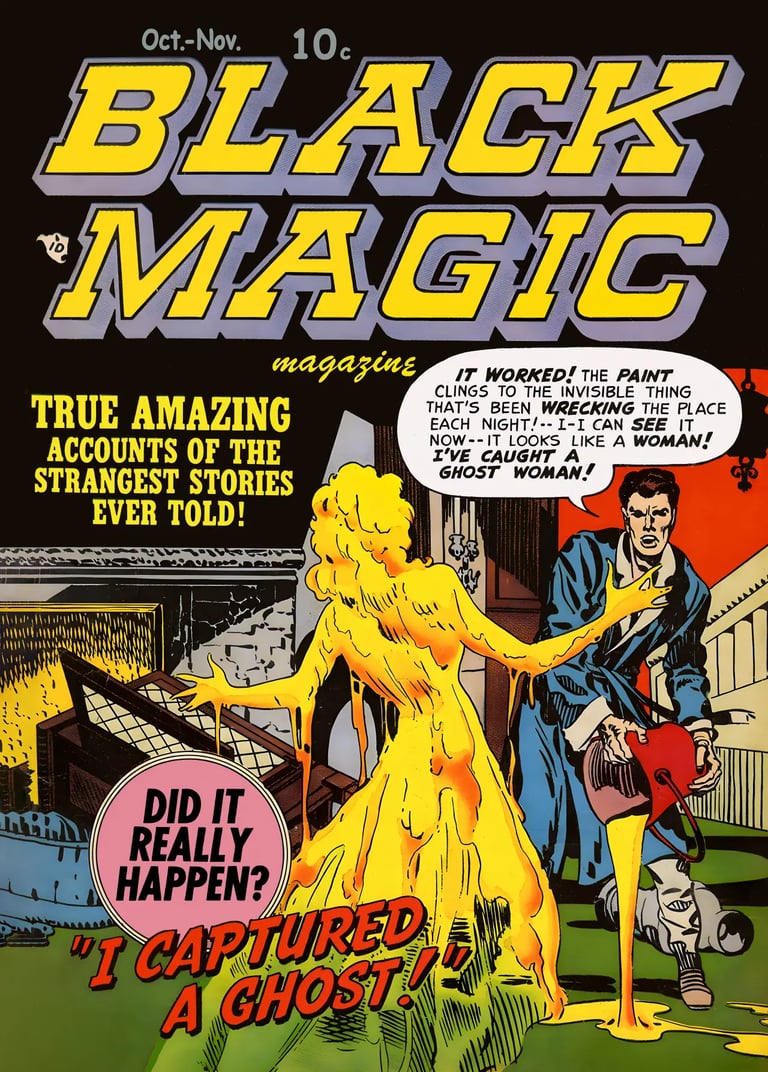

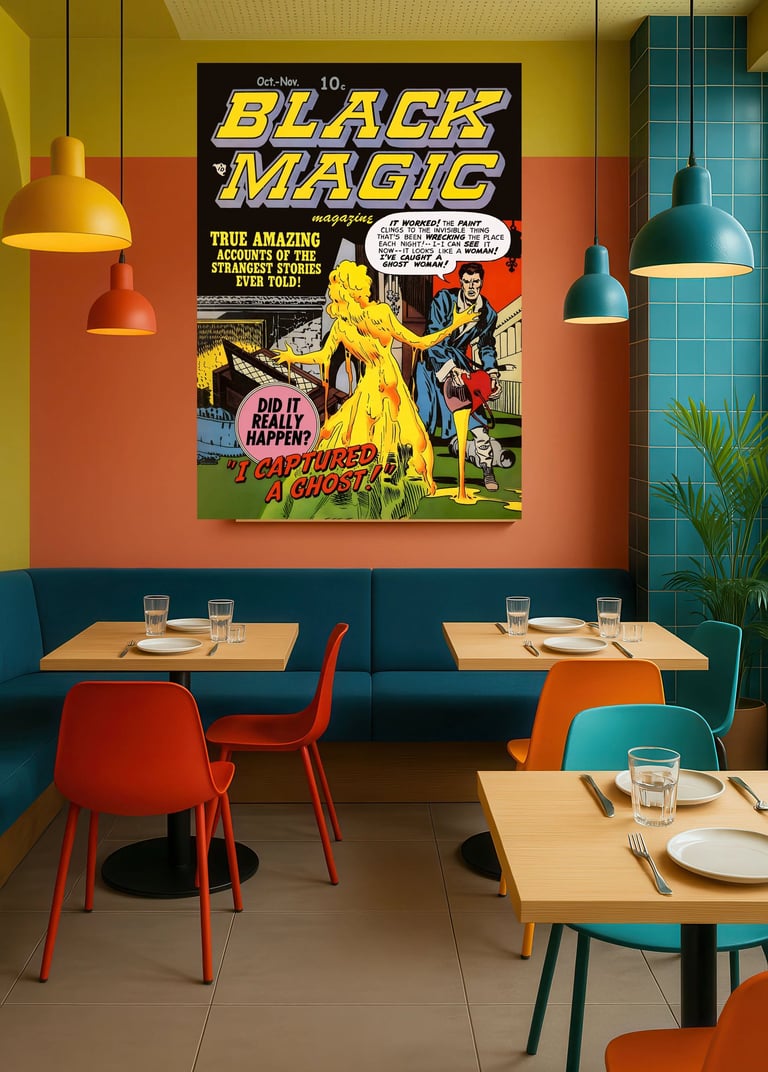

Collectibility: The Treasure Hunt, Now Accessible as Art
The journey of Golden Age comics from ephemeral newsstand items to highly sought-after collector's treasures is remarkable.
Rarity by Design and Circumstance: Original Golden Age comics are incredibly rare. This scarcity is a combination of several factors:
Limited Print Runs: While some popular titles had significant print runs, they were still far fewer than later comic eras.
Cheap Materials: Printed on acidic, low-quality newsprint, these comics were never meant to last. They rapidly deteriorated.
"Throwaway" Mentality: In the 1940s, comics were seen as disposable entertainment for children, read once and then discarded, traded, or recycled. The idea of "collecting" comics for future value was virtually nonexistent until much later decades.
WWII Recycling Drives: During World War II, there were massive paper recycling drives to support the war effort. Millions of comics were donated, pulped, and recycled, further reducing the number of surviving copies. Some comics were even printed with only one staple due to material shortages, making them even more fragile.
The "Holy Grails" of Collecting: This rarity has driven the value of high-grade Golden Age comics into the stratosphere. Issues like Action Comics #1 (first Superman) and Detective Comics #27 (first Batman) are considered the "holy grails" of comic collecting, fetching millions of dollars at auction. The 2021 sale of a near-mint Whiz Comics #2 for $1.5 million underscores the feverish demand for these historical artifacts.
Cover-Driven Value: The value of Golden Age comics is often heavily tied to the iconic nature and condition of their cover art. A striking, memorable cover, especially one depicting a significant character debut or historical moment, dramatically increases its worth. "Pre-Code horror" covers, for example, are particularly sought after by collectors precisely because of their often gruesome, controversial, and visually arresting imagery. This makes them ideal for high-quality, display-worthy prints for your walls, offering the visual impact without the multi-million dollar price tag.
A Hot Market, and Accessible Art: The market for Golden Age comics is currently "very hot," with a surge of interest from younger collectors who are recognizing their historical and artistic significance. For many, owning an original is an impossible dream. This is where high-quality metal prints offer an accessible and visually stunning way to celebrate this history, allowing fans to own and display these iconic covers without requiring a vault or a vast fortune. You can appreciate the art and history every day.
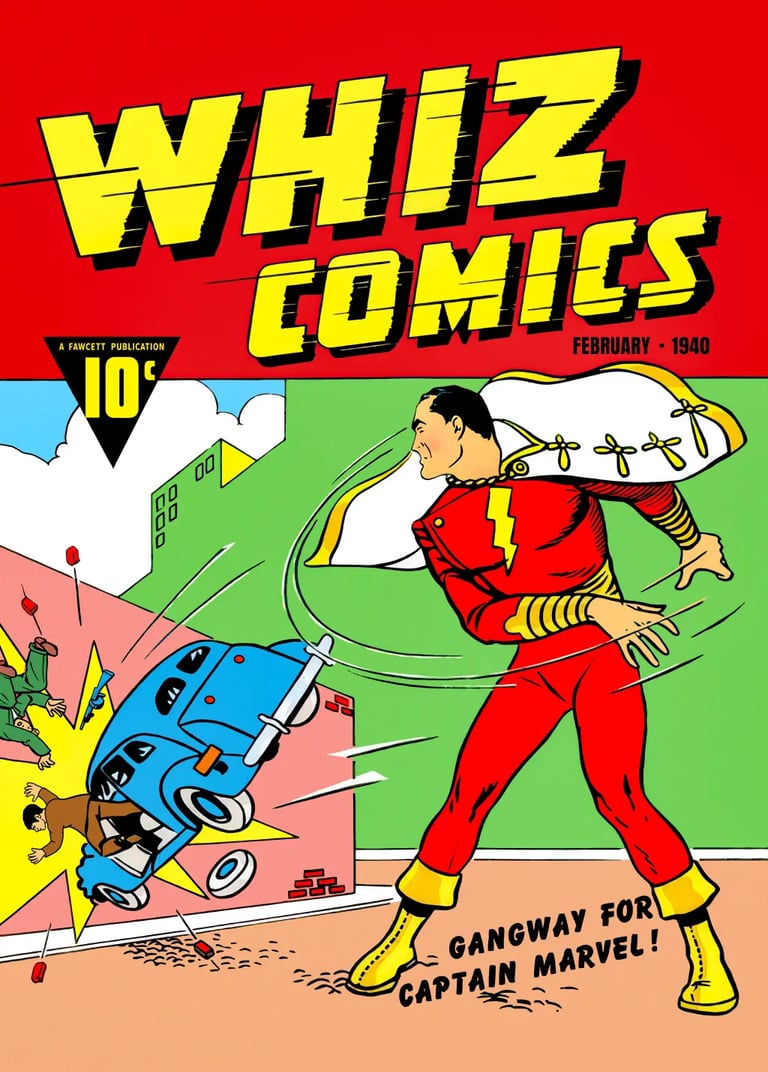

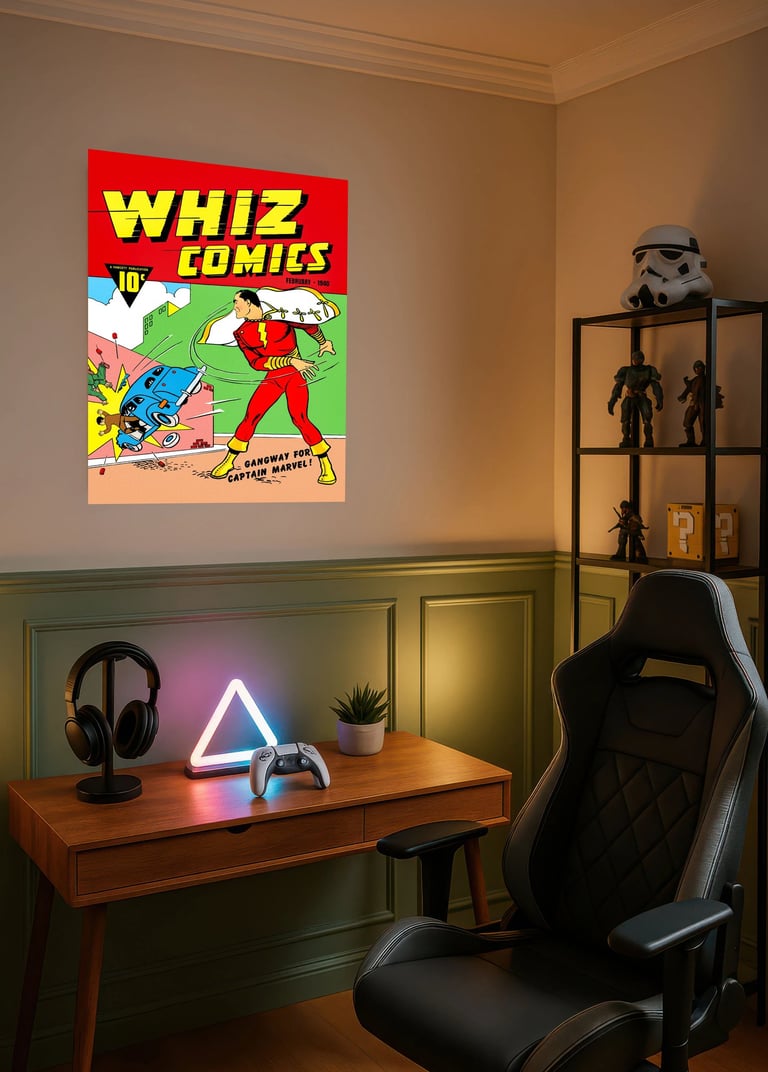

V. Conclusion: Bringing the Golden Age to Your Walls with Punch Comics Shop
In conclusion, Golden Age comic covers are far more than mere historical artifacts. They are vibrant, culturally significant pieces of art that continue to captivate and inspire. Their bold aesthetic, dramatic storytelling, and deep ties to a transformative period in human history make them genuinely unique. They are perfect for transforming any space into a tribute to comic history, a statement of unique taste, and a vibrant focal point.
At Punch Prints Shop, we believe these masterpieces deserve to be celebrated beyond dusty longboxes and museum vaults. We bring them to life as stunning, durable metal wall art, allowing you to experience their full impact every single day. Our exclusive metal prints capture the original intensity and vibrant colors, offering a premium way to own a piece of this incredible legacy.
Each print from Punch Prints Shop is a testament to quality, designed to be scratch-proof, rust-resistant, and built to last a lifetime. With our easy magnetic mounts, transforming your lounge, office, game room, or collector’s gallery into a personal exhibition of comic history is effortless.
Why just dream about owning a piece of the Golden Age when you can make it a tangible part of your everyday life? Explore our exclusive collection of high-quality, Golden Age-inspired metal prints. Each print allows you to bring a piece of this vibrant history, with its bold artistry and compelling narratives, directly into your home or office. Rediscover the magic of a bygone era and make its legendary covers a part of your daily life – boldly displayed as your personal gallery of comic history!
Ready to make your space legendary? Explore the Punch Prints Shop collection today and own a piece of comic art history!
